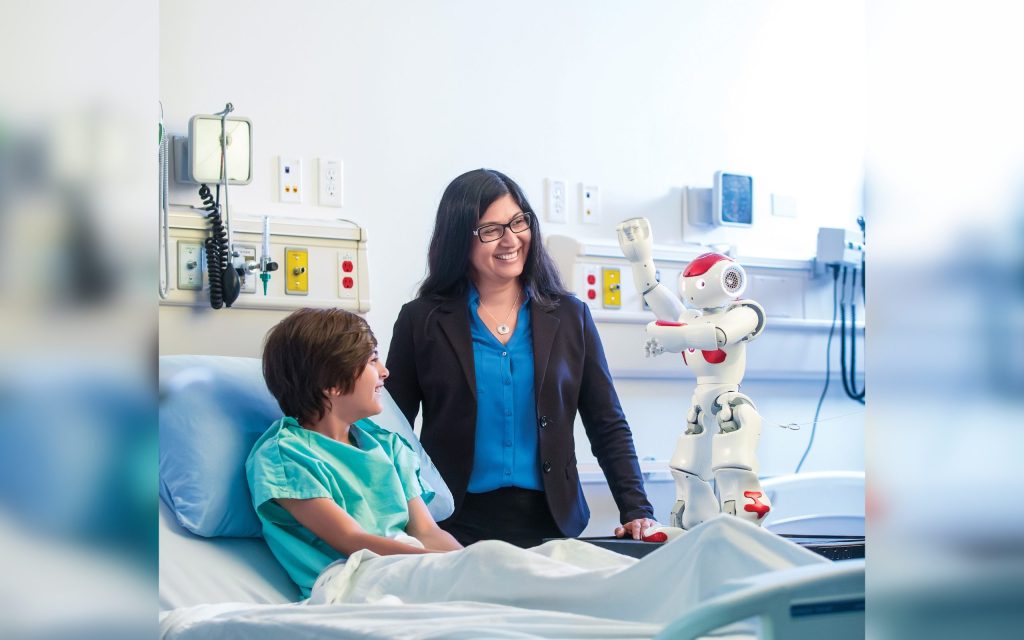Meet MEDi: a robot designed to help children in hospital manage pain, anxiety

An Edmonton researcher is helping develop a new version of an interactive humanoid robot to help children in hospital manage pain through distraction.
Dr. Samina Ali, a pediatric emergency physician at Edmonton’s Stollery Children’s Hospital, says the original MEDi – Medicine and Engineering Designed Intelligence – was a big success.
It was shown to help ease children’s stress and anxiety when undergoing medical procedures in hospital.
Advertisement
“There are sort of two aspects to a difficult procedure,” said Ali, who is also a professor of pediatrics and emergency medicine at the University of Alberta. “One is the physical pain, and one is the emotional build-up and anxiety.
“So we have great creams and medication to help with the pain, but we also need to address the psychological part of being scared of the needle. And the robot was fantastic for that.”
Now researchers are developing a new and more advanced robot.
“We will see if this robot is able to read the room better,” said the physician. “So if the child is happy or upset with their interaction, it can adjust its script accordingly.”
Testing for usability next year
Ali says testing for usability on the updated iteration of MEDi will begin in the new year. Testing will start with families in the emergency department, followed by a clinical trial six to 12 months after that.
Advertisement
The programming of the new robot started in 2020 and is a collaboration between four universities in Canada: University of Alberta, Toronto Metropolitan University, McMaster University and University of Toronto. Two universities in Scotland are also involved: University of Glasgow and Heriot-Watt University.
“We’re going through all of the phases of developing it. We are currently about two years into that project, and we are now almost ready.”
Long-term effects of ignoring children’s anxieties
While on the surface MEDi may seem “fun and light” as merely a distraction tool to improve a child’s hospital experience, Ali says there are important short- and long-term effects as well.
“If we ignore children’s pain and distress around medical procedures, it has immediate short-term consequences,” she said. “They get stressed out, we can’t do the procedure, they have terrible memories.
“Long term, it can actually impact how they perceive future pain. They can start avoiding health care. And so it can cause unhealthy health-care behaviours as adults, and needle-phobia is one of the big ones.
Advertisement
“It’s an investment for a healthier future for Canada.”
Ali says IV insertions are among the most performed procedures for children seeking medical care, and are often a painful and stressful experience for both children and their caregivers. The robot was used during this procedure for research and found it helped to make the experience less painful
“It made them less stressed,” she said.
Trial and error to determine best tech
Before the original MEDi was created, it took some trial and error before researchers determined an interactive robot was the best technology to explore at length.
“We’ve tried a whole bunch of things,” said Ali. “We started with iPads, virtual reality goggles, and then at one point we moved onto robots because they are novel, kids aren’t familiar with them, maybe that will capture their attention and help them experience less pain and stress during procedures.”
Advertisement
MEDi robot has been used for research at the Stollery since 2017.
Part of the testing included sending MEDi into the waiting room at the Stollery.
“And so we had the robot explain to the adults in the wait room why their children are waiting, and how to cope with that stress during that time,” said Ali. “And we actually found that it reduced the stress and improved the satisfaction for the parents, even before they saw a doctor.”
The Edmonton researcher says she is currently working with Stollery administration to bring MEDi into circulation – beyond the research stage.

